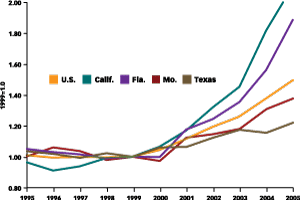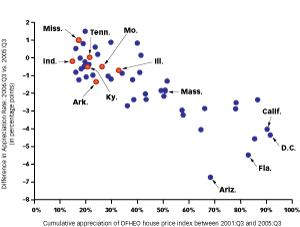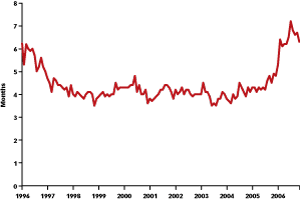Housing Slump Could Lean Heavily on Economy
During the recent housing boom, U.S. house prices seemed to shoot up faster than crabgrass. Homeowners enjoyed an average increase of 54.4 percent in the value of their houses between 2001 and 2005, as measured by a house price index produced by the Office of Federal Housing Enterprise Oversight (OFHEO).1 However, as Tip O'Neil, the former speaker of the U.S. House of Representatives, used to say about politics, all housing markets are local.
The extent to which a given homeowner saw an increase in the value of her house during the boom was largely determined by its location. Between 2001 and 2005, houses in the Port St. Lucie-Fort Pierce, Fla., area rose in price by an average of 144 percent—the largest increase of any U.S. metropolitan area. By contrast, house prices in Lafayette, Ind., rose by a mere 11 percent on average—the smallest increase among U.S. metropolitan areas. The 10 metropolitan areas with the largest increases in house prices were all located in either Florida or California, whereas four of the markets with the smallest rises were located in Indiana.
Figure 1
Ratio of House Prices to Income Varies Dramatically Across States

The figure shows the ratio of the OFHEO house price index to median household income (index divided by income) for selected states and the country. The ratio increased by about 50 percent between 1999 and 2005 for the United States as a whole. It rose by nearly 90 percent in Florida, by over 100 percent in California, by 38 percent in Missouri and by just 22 percent in Texas.
Historically, differences in income and population growth largely explain why house prices rise at different rates in different markets. In June 2005, the U.S. Census Bureau announced that Port St. Lucie was the fastest-growing city in the United States; so, the rapid rise in that city's house prices is not surprising. Many other cities that had large increases in house prices during the boom also had rapidly growing populations. However, the phenomenal rise in house prices in some markets during the past five years has left many analysts questioning whether such fundamentals as population and income growth alone can explain the recent boom.
Controlling for differences in median household income, we still find tremendous variation in house price growth rates across markets. Figure 1 shows the average level of house prices, as measured by the OFHEO index, relative to median household income for various states and for the United States as a whole between 1995 and 2005. The values of the ratio are set equal to 1 in 1999 to more readily compare the change in house prices relative to income across states during the boom. Whereas the ratio of house prices to income increased by about 50 percent between 1999 and 2005 for the United States as a whole, the ratio increased by nearly 90 percent in Florida and by over 100 percent in California. On the other hand, the ratio rose just 22 percent in Texas and 38 percent in Missouri.
Differences in the cost and availability of land for new construction might explain some of the differences in the growth of house prices relative to median income across states. However, many commentators argue that "speculative bubbles" drove house prices in many markets that had the most rapid increases in average house prices. The economist Robert Shiller defines a speculative bubble as "a situation in which temporarily high prices are sustained largely by investors' enthusiasm rather than by consistent estimation of real value."2 Indirect evidence of speculative bubbles in housing markets includes high rates of buying second or third homes by investors and others who hope to resell them for a quick profit.
Although many commentators have argued that speculative bubbles arose in housing markets throughout the United States, in the sober world of economic analysis, conclusive evidence of bubbles has been hard to come by. Mortgage interest rates fell to unusually low levels during the early 2000s, which reduced the cost of buying and owning a home. Further, a limited quantity of land available for new construction kept the supply of housing from increasing as rapidly as demand in many markets, especially on the East and West coasts.3 Still, in the words of former Federal Reserve Chairman Alan Greenspan, many U.S. housing markets showed signs of considerable "froth."4
The End of the Boom
The growth in U.S. house prices peaked in the third quarter of 2005— the same quarter, perhaps coincidentally, that hurricanes Katrina and Rita struck the Gulf Coast and analysts began to warn of slowing in the U.S. economy. Mortgage interest rates also began to rise in that quarter. Since then, the growth of home prices has slowed dramatically, from an average annual growth rate of 11.2 percent in the third quarter of 2005 to a mere 1.5 percent in the third quarter of 2006, as measured by the seasonally adjusted OFHEO house price index based only on purchase transactions.
Some analysts believe that the anemic rate of price growth shown by the OFHEO index may actually overstate the true rate of increase in U.S. house prices in the current environment. One reason is that the OFHEO index is based only on recent sales, and houses that sell in a down market are likely to be relatively more appealing than average and perhaps hold their values better than other houses do. The index also excludes sales involving mortgages over $417,000, which is the upper limit for loan purchases by Fannie Mae and Freddie Mac, the two largest players in the secondary mortgage market. Sales involving larger mortgages, which are especially common in the areas of the country that saw the most house price appreciation during the boom, do not influence the OFHEO index. By contrast, the median sales price of existing homes calculated by the National Association of Realtors is based on a random sampling of all existing home transactions from throughout the country, including those involving large mortgages or even no mortgage at all.5 The median sales price of existing single-family houses peaked at over $230,000 in July 2006. Although prices usually decline in fall and winter months, the decline in 2006 was somewhat larger than usual. In November 2006, the median sales price was $217,000, which was $8,000 below the median in November 2005.
Figure 2
States' House Price Appreciation Rates during the Boom and After

States that had large increases in home prices during the boom had large drops in price appreciation rates once the boom ended. Arizona, for example, saw housing prices jump 70 percent between 2001 and 2005; in the following year, the increase in house prices dropped seven percentage points. On the other hand, states that experienced small gains during the boom had smaller drops afterward. All the states in the Eighth Federal Reserve District (orange dots) fell into this latter group.
All states have experienced a slowing in the growth of house prices since the third quarter of 2005. However, as shown in Figure 2, the slowing has been the most pronounced in states that experienced the largest gains in house prices during the boom. The figure plots state-level observations on the change in the house price appreciation rate, as measured by the OFHEO index, between the third quarter of 2005 and the third quarter of 2006 against the cumulative increase in house prices during the four-year period ending in the third quarter of 2005. For example, during the boom, house prices in Arizona rose by an average of nearly 70 percent. However, the growth of house prices in Arizona slowed dramatically after the boom. During the third quarter of 2006, Arizona house prices rose at an average rate that was nearly seven percentage points below the rate experienced during the third quarter of 2005. Other states that had large increases in house prices during the boom, then large declines in house price appreciation rates, include California and Florida, as well as the District of Columbia. It should be noted, however, that despite large declines in their growth rates, Arizona, California, the District of Columbia and Florida continued to have comparatively high rates of house price appreciation through the third quarter of 2006.
Most states in the Midwest and South had far smaller increases in house prices during the boom, but also saw relatively little subsequent slowing in their house price appreciation rates. These states continue to have comparatively slow appreciation rates, however, and a few states that experienced little appreciation during the boom, such as Michigan, have also seen large declines in house price growth since the third quarter of 2005.
What about a Bust?
Analysts have been predicting a collapse of house prices for several years. In the past, some house price booms were followed by large price declines. However, other booms simply fizzled out into extended periods of flat or slowly rising house prices. In the 1980s and 1990s, there were 20 state-level housing booms, defined as three or more quarters of annualized growth in excess of 7 percent in the ratio of house prices to state per capita income.6 Of these booms, 10 were followed by declines in nominal house prices of at least 5 percent and nine were followed by declines of more than 10 percent over a period of four or more quarters. The other 10 booms were followed by extended periods of either flat or slowly rising prices, indicating that the adage "what goes up, must come down" does not always apply to housing markets.7
By the same token, several instances of large declines in house prices were not preceded by a boom. Several Midwestern farm and manufacturing states experienced price declines of 10 percent or more during the early 1980s, as did a number of energy-producing states in the mid-1980s. All of the declines occurred when falling commodity prices or declining profits in older manufacturing industries caused large declines in state personal incomes. Later in the 1980s and into the 1990s, house price busts occurred in New England, California and Hawaii. All of these states had experienced housing booms, marked by large increases in the ratio of house prices to income, before prices collapsed.
Most markets did not experience a significant decline in house prices during 2006. However, nationwide the construction of new homes plunged. From a seasonally adjusted peak of 2.3 million units in January 2006, the number of new, privately owned housing units of all types that were started fell to an annual rate of just 1.5 million units in October, its lowest level since July 2000, before increasing to 1.6 million units in November.
Starts of single-family houses followed a similar pattern. Sales of new and existing homes also plunged, leaving the inventory of unsold homes on the market at unusually high levels. For example, throughout most of 2006, the inventory of new one-family houses for sale exceeded a seasonally adjusted six-months' supply at current sales rates. As Figure 3 shows, this level of inventory had not been seen since 1996. During the boom, the inventory of new houses on the market was frequently less than a four-months' supply.
During 2006, the slowdown in housing sales and construction mainly affected persons whose livelihoods were directly tied to the housing industry, such as construction workers, real estate agents and mortgage brokers. Analysts estimate the slump reduced U.S. GDP growth by approximately one percentage point during the second half of 2006. If the slump worsens, and especially if house prices fall sharply, the consequences for the national economy could become even more serious.
The large increase in average U.S. home prices between 2001 and 2005 contributed to an enormous increase in household wealth, which helped to fuel growth in consumer spending. Analysts fear that by destroying wealth, a decline in house prices would reduce consumer spending and possibly drag the economy into a recession. Further, falling house prices would erode the value of collateral behind the $9.5 trillion residential mortgage debt market and, thereby, increase the losses that lenders experience on loan defaults.
Analysts have debated the extent to which consumers spent the capital gains they enjoyed on their houses during the boom and, therefore, the extent to which consumer spending would fall as a result of a decline in house prices. Standard economic theories of consumption argue that an increase in wealth will lead to an increase in spending, but that higher spending will be spread out over a person's lifetime and have relatively little impact in any one year. Economists estimate that for every dollar increase in wealth, current spending will rise on the order of 2.5-5 cents. Some economists argue, however, that increases in housing wealth have a larger impact on spending than increases in other forms of wealth, such as stocks and bonds. One reason for this differential impact is that housing typically comprises a larger share of the assets of lower-income persons, who may have a higher marginal propensity to consume, than it does of high-income persons. Moreover, many households have little collateral for loans other than their house; so, an increase in the value of their houses can ease constraints on their borrowing and spending.
A key aspect of the debate about the impact of the recent housing boom on consumer spending has centered on the use of funds obtained from the refinancing of mortgages and home-equity lines of credit. During the boom, homeowners extracted over $1 trillion of equity from their homes through cash-out refinancing and home-equity loans. Unfortunately, the data do not exist to tell us definitively how these dollars were used. Some analysts estimate that as much as 60 percent of extracted equity was used for consumption which, if true, would suggest that a decline in housing wealth could seriously erode consumer spending. Other studies conclude that much of the wealth pulled out of houses was invested or used to pay down other household debt, and relatively little was consumed. These estimates suggest that a modest fall in house prices would not lead to a sharp pullback in spending.8
A Squeeze on Lenders
In addition to having a potentially large impact on consumer spending through a reduction in wealth, a serious decline in house prices could also reverberate through the economy by eroding the capital of banks and other lenders that experience increased defaults on real estate loans. In the 1980s and early 1990s, losses from real estate loan defaults chewed up lender capital and contributed to a rise in bank and thrift (e.g., savings and loan) failures.9 The banks' weak capital positions not only constrained their ability to lend but also slowed the pace of the economic recovery from the recession of 1990-91, then-Federal Reserve Chairman Greenspan argued at the time.10
Compared with the condition of banks around 1990, U.S. banks today are on the whole much better capitalized and, thereby, better able to withstand a modest increase in real estate loan defaults. Nevertheless, as a share of bank assets, residential real estate loans and securities rose sharply during the recent housing boom.
Although a considerable amount of these loans and securities is guaranteed by third parties, banking regulators have expressed concern recently about the increased exposure of banks to real estate (both residential and commercial), especially in light of the increased use of non-traditional mortgage loan products.11 These products, which include interest-only loans and adjustable-rate loans that permit negative amortization, expose borrowers and lenders to greater house-price and interest-rate risk than traditional mortgage loans do. Hence, either a decline in house prices or an increase in interest rates could increase mortgage delinquencies and reduce lender profits. Consequently, banking supervisors are keeping an eye on the exposure of banks to real estate, as well as their overall safety and soundness, to try to minimize the damage that would result from any collapse in real estate prices.
Summing Up
The recent housing boom produced some dramatic increases in house prices in many parts of the United States. Prices soared in hot markets where rapid population and income growth drove up the demand for housing faster than supply. Some of these markets showed signs of speculative bubbles, including high rates of investor purchases, but the existence of bubbles is difficult to prove. Unfortunately, the difficulty of determining the extent to which prices rise in excess of fundamental value makes it difficult to forecast whether prices are going to fall. Looking back at regional housing booms in the United States during the 1980s and 1990s, we find that while some periods of rapidly rising house prices were followed by large price declines, others were followed by periods of flat or slowly rising prices. Moreover, in some states, large declines in house prices were not preceded by a boom. Hence, the presence of a boom does not necessarily portend a bust.
If house prices do fall in many markets, we will probably see an increase in mortgage loan defaults, as well as continued distress for persons engaged in housing construction and in other real estate-related employment. The extent to which a decline in house prices would affect consumer spending is uncertain, however. Hence, policymakers will continue to watch closely for signs that a housing slump is having a broader impact on the economy.
Endnotes
- This calculation is the percentage increase in the seasonally adjusted OFHEO repeat-sales house price index for purchase transactions only between the fourth quarters of 2000 and 2005. See www.ofheo.gov/HPI.asp. [back to text]
- Shiller (2005), p. xviii. [back to text]
- Himmelberg, Mayer and Sinai (2005) and Smith and Smith (2006) are two recent studies that conclude that economic fundamentals can explain the rapid growth in house prices in most U.S. housing markets. [back to text]
- "The Economic Outlook." Testimony of Chairman Alan Greenspan before the Joint Economic Committee, U.S. Congress, June 9, 2005. [back to text]
- See www.realtor.org/research.nsf/pages/ehspage. [back to text]
- For comparison, between 2001 and 2005, 17 states experienced increases in the ratio of house prices to per capita income of at least 7 percent for three or more consecutive quarters, and this ratio rose at an average 5.4 percent annual rate during 2001:Q1-2005:Q1 for the United States as a whole. [back to text]
- See Wheelock (2006). [back to text]
- See McCarthy and Steindel (2006) for more information and estimates of the influence of changes in housing wealth on consumer spending. [back to text]
- See Federal Deposit Insurance Corp. (1997). [back to text]
- "Risk and Uncertainty in Monetary Policy." Remarks by Chairman Alan Greenspan at the Meetings of the American Economic Association, San Diego, Calif., Jan. 3, 2004. [back to text]
- For example, see "A Supervisor's Perspective on Mortgage Markets and Mortgage Lending Practices." Remarks by Gov. Susan Schmidt Bies at the Mortgage Bankers Association Presidents Conference, Half Moon Bay, Calif., June 14, 2006. [back to text]
References
- This calculation is the percentage increase in the seasonally adjusted OFHEO repeat-sales house price index for purchase transactions only between the fourth quarters of 2000 and 2005. See www.ofheo.gov/HPI.asp.
- Shiller (2005), p. xviii.
- Himmelberg, Mayer and Sinai (2005) and Smith and Smith (2006) are two recent studies that conclude that economic fundamentals can explain the rapid growth in house prices in most U.S. housing markets.
- "The Economic Outlook." Testimony of Chairman Alan Greenspan before the Joint Economic Committee, U.S. Congress, June 9, 2005.
- See www.realtor.org/research.nsf/pages/ehspage.
- For comparison, between 2001 and 2005, 17 states experienced increases in the ratio of house prices to per capita income of at least 7 percent for three or more consecutive quarters, and this ratio rose at an average 5.4 percent annual rate during 2001:Q1-2005:Q1 for the United States as a whole.
- See Wheelock (2006).
- See McCarthy and Steindel (2006) for more information and estimates of the influence of changes in housing wealth on consumer spending.
- See Federal Deposit Insurance Corp. (1997).
- "Risk and Uncertainty in Monetary Policy." Remarks by Chairman Alan Greenspan at the Meetings of the American Economic Association, San Diego, Calif., Jan. 3, 2004.
- For example, see "A Supervisor's Perspective on Mortgage Markets and Mortgage Lending Practices." Remarks by Gov. Susan Schmidt Bies at the Mortgage Bankers Association Presidents Conference, Half Moon Bay, Calif., June 14, 2006.
Views expressed in Regional Economist are not necessarily those of the St. Louis Fed or Federal Reserve System.
For the latest insights from our economists and other St. Louis Fed experts, visit On the Economy and subscribe.
Email Us



